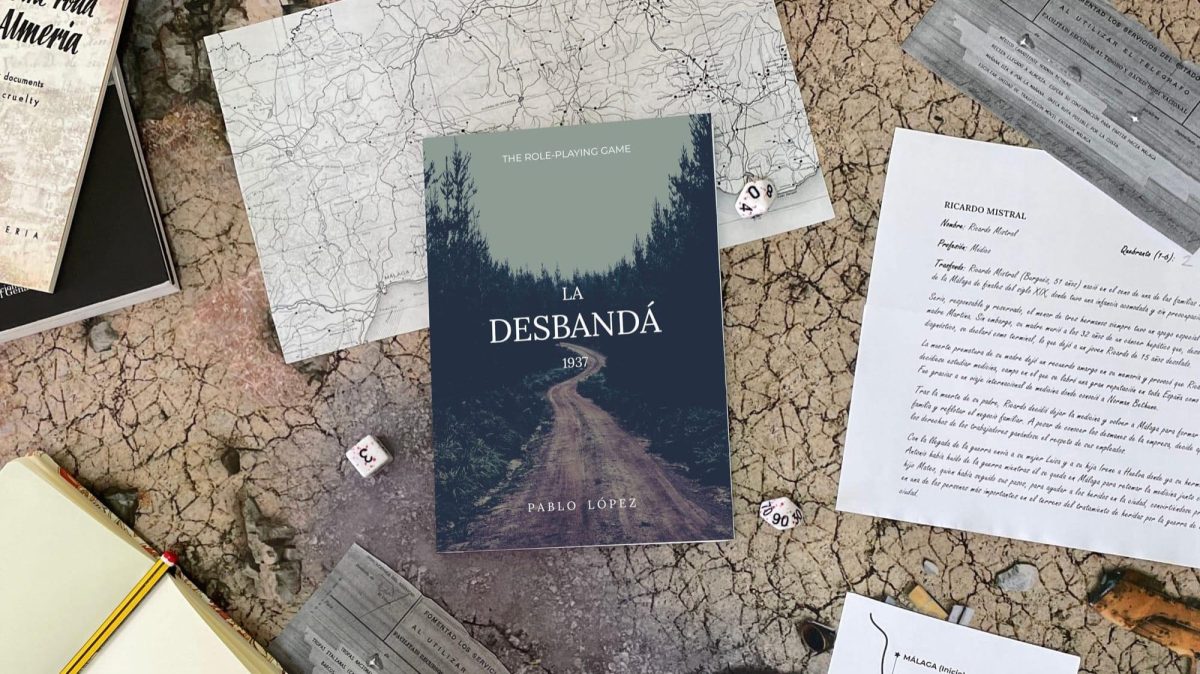La Desbandá 1937,[1] a historical role-playing game, transports players to one of the most harrowing episodes of the Spanish Civil War: the mass exodus of civilians from Málaga to Almería in February 1937, known as la desbandá. In 1936, a failed coup d’état had ignited a civil war in Spain. By early 1937, Málaga was one of the few areas in southern Spain still outside fascist control, but it was surrounded, and its fall was imminent. Fearing reprisals, thousands of people from Málaga fled the city with only what they could carry, heading toward Almería along the only remaining escape route: the Málaga-Almería coastal road. This devastating flight, marked by fear and violence, and resulting in the tragic deaths of 3,000 to 5,000 civilians, remains one of the conflict’s darkest chapters. Through interactive storytelling, the game seeks not only to illuminate this often-overlooked event but also to honour its victims and explore the complex dimensions of its history.
The nature of la desbandá, composed of countless individual experiences, lends itself perfectly to the narrative form of role-playing games. This format allows players to explore the intertwined stories of survivors, creating an involving and personal historical experience.
By immersing players in this tragic event, La Desbandá 1937 aims to preserve historical memory and underscore the importance of learning from the past. In doing so, it reminds us that humanity and compassion can endure, even in the face of immense hardship.
History as the main character
La Desbandá 1937 distinguishes itself from other games by placing history front and centre, not as mere backdrop but as an essential foundation. Built upon an evidence-based approach, the game draws on a range of biographical sources to create a grounded and immersive experience that respects the historical context while allowing player choice. Jesús Majada’s Carretera Málaga-Almería,[2] considered a definitive account of the massacre, provides detailed insights into the tragic events surrounding la desbandá. The firsthand account of Canadian doctor Norman Bethune in The Crime on the Málaga-Almería Road[3] offers a moving, human perspective on the massacre, as he witnessed its horrors while providing critical medical aid to those in need.
The game also incorporates information from video documentaries featuring survivor testimonies, helping players form an emotional connection to the personal experiences of those who endured this tragedy. Additional resources, such as a military atlas of the Spanish Civil War,[4] supply essential context about regional military operations, aiding players’ understanding of the conflict’s dynamics and their toll on the civilian population. Historical photography[5] serves as a reference, transporting players to the era and the circumstances surrounding la desbandá. Meanwhile, the fictional novel La desbandá[6] by Luis Melero enriches the game’s narrative with deeper insight into the historical setting.

While the game adheres closely to historical events, it acknowledges that certain aspects of this era remain uncertain or incomplete. To address this, it prioritizes historical evidence by carefully integrating essential elements—such as road layouts, daily events, battles, and attacks. Artistic license has been selectively employed, using fictional elements to enhance and streamline the narrative, all while preserving the historical essence of the game.
In incorporating fictional elements, careful consideration was given to ensure they complemented rather than detracted from the historical narrative. Examples include the creation of an initial narrative hook to engage players, the inclusion of a traitor within the group of players, and a list of random encounters designed to be used during gameplay. These fictional additions were crafted to be largely independent of the historical backdrop, ensuring they do not alter the documented events or distort the reality of la desbandá.
The primary challenge lay in balancing these creative elements so they neither confused nor distracted players from the historical aspects. To address this, the fictional components were designed to remain plausible and consistent with what might have occurred in reality, blending seamlessly into the game world. At the same time, they are clearly identifiable as fictional, serving a purely ludic purpose while preserving the historical essence of the experience.
Finally, photographs and descriptions of the era deepen the realism of the scenarios, thoughtfully organized to support both the game’s setting and narrative flow.
Understanding history through gameplay
Through its immersive narrative, La Desbandá 1937 allows players to experience history firsthand, stepping into the roles of survivors as they confront the era’s challenges and moral dilemmas. By focusing on individual stories, the game not only humanises the tragedy but also highlights the profound human cost of war, paying tribute to its many victims. This approach fosters empathy and encourages players to connect emotionally with history, inspiring a deeper, more meaningful understanding.
The story of Canadian doctor Norman Bethune plays a central role in the game, serving as the focal point in the main adventure, In Search of Norman Bethune. Having travelled to Málaga to assist in the city’s defence, Bethune retreated to Almería alongside the refugees as enemy forces advanced. For three days and nights, he transported the wounded to Almería’s hospital, bearing witness to the massacre’s atrocities. His testimony and photographs, recorded in his book The crime of the road Málaga-Almería,[7] helped ensure this event was not forgotten. Bethune’s character thus becomes a historical figure with whom players can interact, enhancing the realism of the experience and creating a powerful connection between the players and the past.
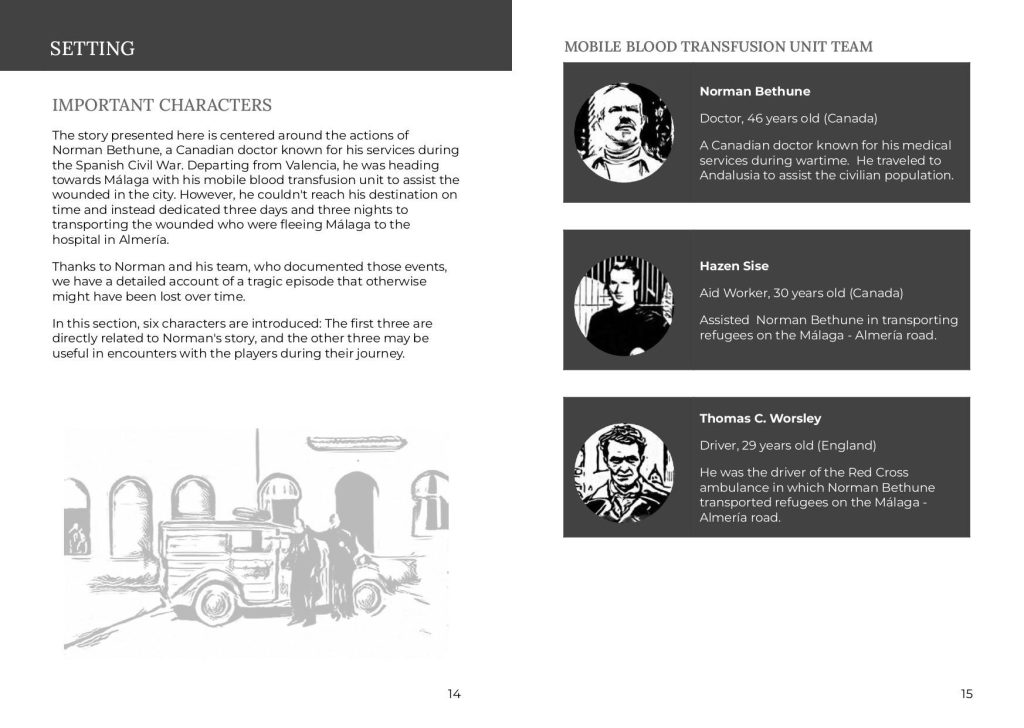
An accessible game system
To make the game approachable for a broad audience, including those new to role-playing games, La Desbandá 1937 employs a simple system based on Cthulhu Dark[8] by Graham Walmsley. This minimalist role-playing system is designed for narrative-driven games, focusing on storytelling and atmosphere rather than complex mechanics. In Cthulhu Dark, players use a single six-sided die to resolve actions, with outcomes depending on the highest number rolled. A key feature of the original system is the Sanity mechanic, which tracks a character’s mental state as they encounter supernatural horrors, gradually driving them toward madness
For La Desbandá 1937, the system has been adapted to the game’s historical context, replacing the concept of “Sanity” with “Collapse”, which represents a character’s physical and moral resilience amid the war’s hardships. The system’s simplicity allows the narrative to remain at the forefront, unobstructed by complex mechanics.
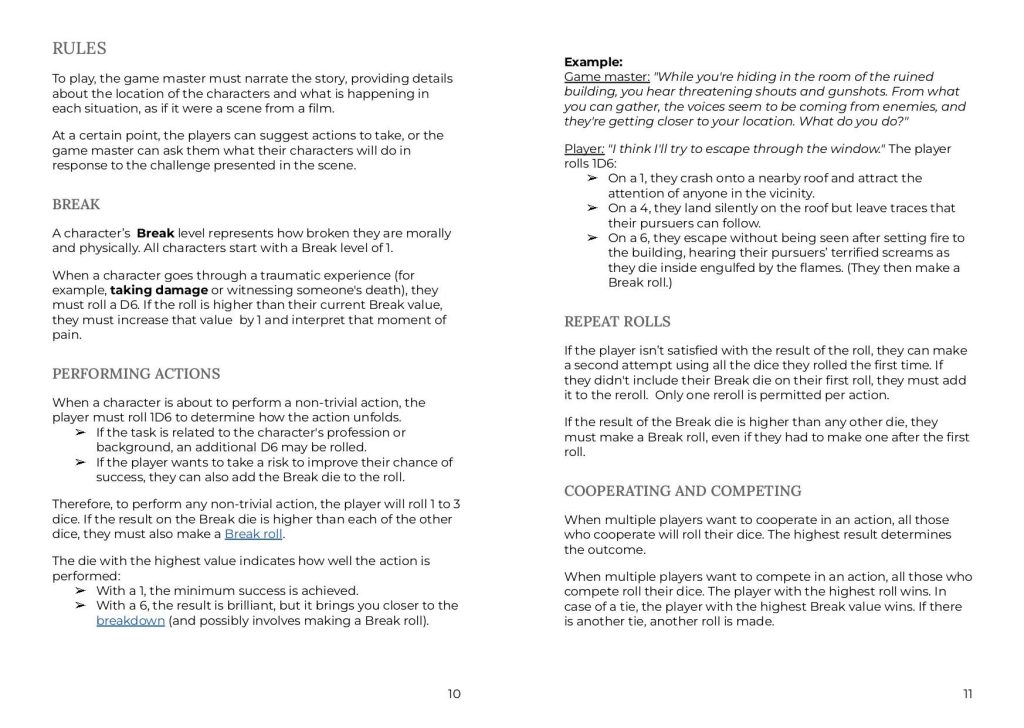
An introductory chapter provides basic information about role-playing games, with practical examples of rules and mechanics throughout the book. For those eager to dive in, pre-generated character sheets are included to streamline the experience.
A legacy of collaboration and dissemination
Since its inception, La Desbandá 1937 has fostered collaborations and educational opportunities, expanding its reach beyond traditional gaming circles. Originally written in Spanish, the game has since been translated into English with support from The Dietz Foundation[9] and into French through collaboration with French creator Doc Dandy.[10]
La Desbandá 1937 initially garnered significant attention from a wide range of audiences, including those unfamiliar with role-playing games. Originally designed as a generic role-playing module compatible with any system, the game’s growing popularity among less experienced players led to a substantial redesign. It was transformed into a standalone game that includes an introduction to role-playing games, a simplified game system, and practical resources such as pre-generated character sheets, making it accessible even to complete newcomers.
On an international level, one of the key challenges was generating interest in a historical event rooted in the Spanish Civil War, a topic that, despite its importance, is often underexplored outside Spain. The collaborative efforts of individuals from diverse disciplines and nationalities have been instrumental in promoting and translating the game. For example, the game was featured at SDHistCon 2024: Second Front!,[11] where it served as the centrepiece of an international discussion on designing historical role-playing games.
La Desbandá 1937 has also gained significant traction in educational contexts. Educators at both high school and university levels have expressed interest in incorporating the game into their teaching, recognizing its value as a tool for exploring history and fostering empathy through immersive storytelling.
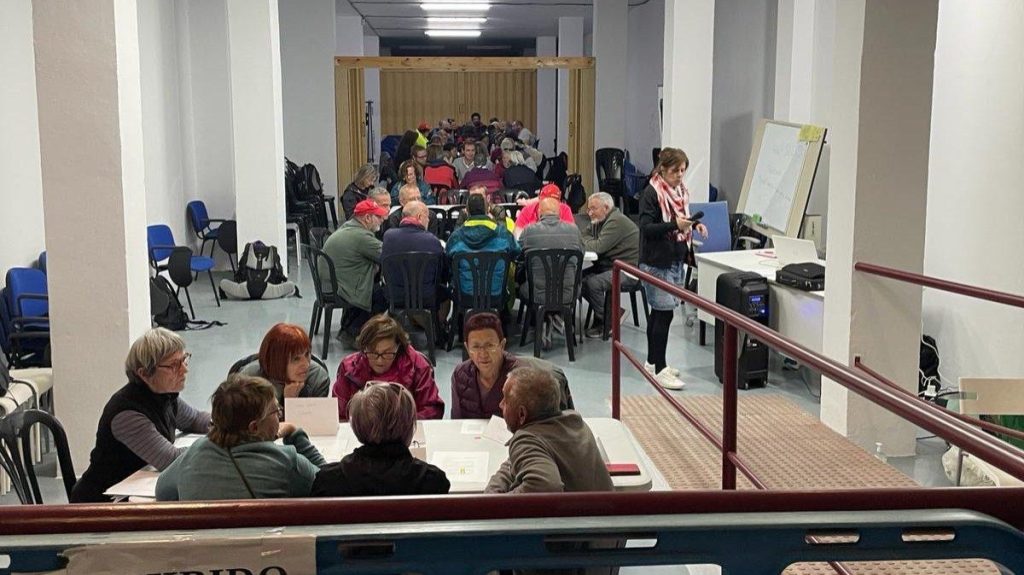
The game also enjoys the support of the Asociación Memorialista La Desbandá,[12] an organization dedicated to raising awareness of the massacre. During the annual reenactment of the civilians’ flight from Málaga to Almería, game sessions of La Desbandá 1937 have been held in one of the towns along the route, creating a moving and immersive experience for participants.
Despite initial concerns about hosting collective role-playing sessions for an audience largely unfamiliar with this type of game, each table managed to develop its own unique interpretation of the scenario. Participants, many of whom were already familiar with the historical events, experienced them in an entirely new way, fostering intriguing reflections and discussions about the stories their groups created. Additionally, the Asociación Memorialista La Desbandá found this approach to be an effective way of engaging younger audiences, introducing them to the history in an immersive and thought-provoking manner.
La Desbandá 1937 tries to be more than just a game; it’s a journey through history, a tribute to the past, and attempts to be a beacon of innovation in storytelling.
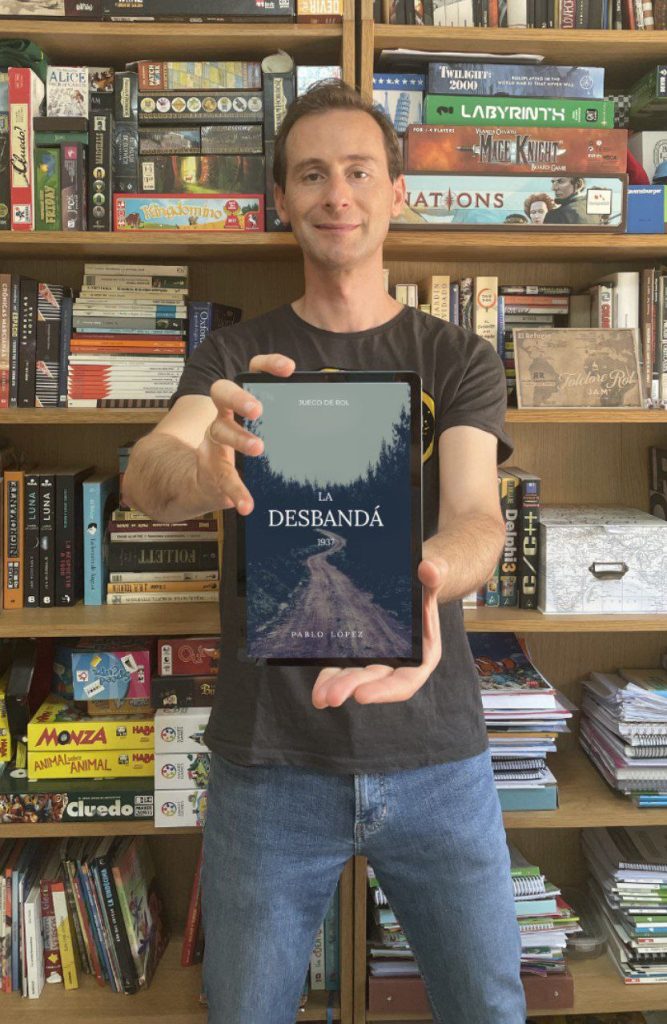
Pablo López (Spain) is the creator of the role-playing games La Desbandá 1937 and El hombre del saco: La historia del crimen de Gádor. Professionally, he is a computer engineer specializing in software development. A technology enthusiast with a passion for history, art, and games in all their forms—video games, board games, or role-playing games—he strives to integrate these disciplines in his game design and gameplay sessions. His journey into game design stems from a deep interest in history and real-world events, elements he weaves carefully into his creations and campaigns. With each project, his aim is not only to entertain but also to engage players in fascinating worlds infused with narrative and reality.
[1] Pablo López. La Desbandá 1937. Self published, 2024. https://yopablo.itch.io/la-desbanda-english
[2] Jesús Majada Neila y Fernando Bueno Pérez. “Carretera Málaga – Almería (Febrero, 1937)”. Caligrama, 2006.
[3] Norman Bethune. “The crime of the road Málaga-Almería”. Publicaciones Ibera, 1937.
[4] Fernando Puell y Justo A. Huerta. “Altas de la Guerra Civil Española”. Editorial Síntesis, 2007.
[5] Paco Elvira. “La Guerra Civil Española. Imágenes para la historia”. Lunwerg Editores, 2011.
[6] Luis Melero. “La desbandá”. Ediciones del Genal, 2015.
[7] Norman Bethune. “The crime of the road Málaga-Almería”. Publicaciones Ibera, 1937.
[8] Graham Walmsley. “Cthulhu Dark”. Thieves of time, 2010.
[9] The Dietz Foundation. https://dietzfoundation.org/
[10] Doc Dandy. https://docdandy.itch.io/
[11] SDHistCon 2024: ‘Second Front’! https://sdhist.com/sdhistcon-2024-second-front/
[12] Asociación Memorialista La Desbandá. https://ladesbanda.es/
